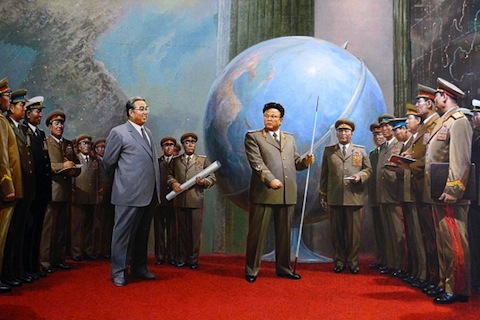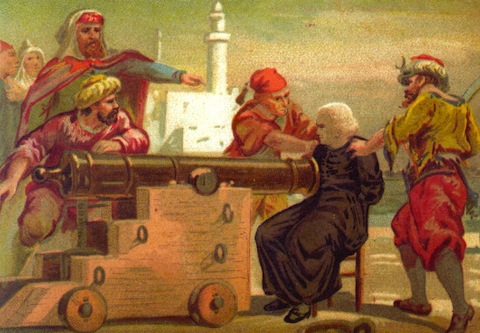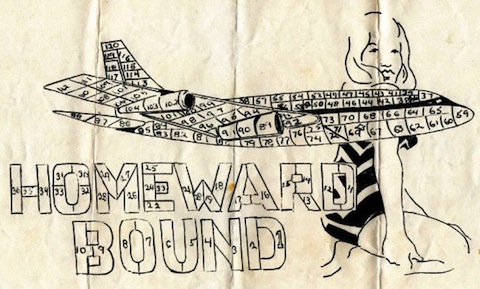January 9th, 2012
One should perhaps never be surprised by the nature of political discourse in a country where the Simon and Garfunkel song “Cecilia” was once banned. Yet there is still something rather jarring about a leader who willfully disparages his own populace, as Malawian President Bingu wa Mutharika did last week:
Mutharika challenged Malawians to appreciate that at [a] certain point a person’s life goes through hard times and currently several countries in the world were going through economic difficulties and Malawi was not exceptional.
“Problems are all over. Several countries are currently going through economic crisis even if you go to United Kingdom in Europe you will find problems.
“Why do you behave like chickens, it is a chicken that just cries kwe kwe kwe (mimicking chicken cry) whenever it hears something…We are not a nation of chicken[s],” said Mutharika in his usual defiant mood.
Perhaps the core spirit of Mutharika’s message isn’t too different from that of American presidents who’ve occasionally urged us to make sacrifices when times are tough. But his motivational technique is bizarre by our standards. Perhaps someone should hand him a fortune cookie that contains the axiom, “You’ll catch more flies with honey than with vinegar.”
Tags:language·Malawi·politics
January 6th, 2012

Taking advantage of a brief lull in the Wired action to steal a day for the book. Back on Monday with a post about the history of submarine rescue, a teaser of which is posted above.
One more thing: If anyone can shed light on the real name of an Algerian secret policeman who went by the handle “No Nuts” in the early 1970s, I’d be much obliged if you could share your intel. He makes some cameos in my book, and I’d like to know more about him. At this point, all I have are vague suggestions that he may have had an unpleasant run-in with a mis-wired bomb during Algeria’s war of independence.
Tags:Algeria·maritime·submarines·The Next Book
January 5th, 2012

I should have mentioned long ago that noted Microkhan ally Nathan Thornburgh has launched a new project near-and-dear to my heart: Roads & Kingdoms, a site that operates under the hard-to-resist motto “Journalism, travel, food, murder, music.” The first several weeks’ worth of posts have focused exclusively on Burma, where Nathan and his co-creator traveled late last year. To their great credit, they made it all the way up to Myitkyina, a scrappy town that makes an important cameo in Now the Hell Will Start. Their photos and stories from up that way are pretty dang awesome.
But Roads & Kingdoms isn’t just about on-the-ground reporting; Nathan and his crew also delve into the data on occasion, such as in this great riff on the lethality of Burma’s highways and byways. The actuary in me loved this bit:
The dry genius of the ADB-ASEAN cost estimate is that it includes estimates for grief and human suffering in the aftermath of an accident. That’s $1,800 in societal grief for every death, $842 for a serious injury accident, $8.28 for a slight injury accident.
I keep on wondering how they tacked on that twenty-eight cents to the minory-injury estimate. And, more important, the factors that affect how those sorts of figures translate to more developed nations. Do the bean counters assume that grief is greater in places where violent death is rarer? Or are assumptions not part of the process here, and there is some sort of griefometer that automates the gathering of data?
Tags:Burma·cars·economics·public health·Roads & Kingdoms
January 4th, 2012
Amid all the wearying hullabaloo over the Iowa caucus, the passing of a major figure in American history seemed to have slipped off the radar. Gordon Hirabayashi, who died at 93 on Monday, was one of a small handful of Japanese-Americans to legally contest the Roosevelt Administration’s internment policy—a policy that, in this project’s humble opinion, was a national shame of the highest order. The 1943 New York Times piece (PDF) recounting the failure of Hirabayashi’s lawsuit against the federal government did a good job of explaining his Kafkaesque situation:
Hirabayashi, born in Seattle twenty-five years ago was a senior at the University of Washington and had never been in Japan, whence his parents came. He was sentenced to serve three months for violating the curfew regulation and three months for failing to register for evacuation from the military area.
So much for the promise that anyone can reinvent themselves as an American. And yet Hirabayashi never lost faith that the internment scandal was just as an aberration, summing up his attitude in a quote that deserves to be remembered for the ages:
I was able to hold my head up high, because I wasn’t objecting and saying “no,” but was saying “yes” to a prior principle, the highest of principles.
Hirabayashi was finally vindicated over four decades later, when a federal appeals court overturned his conviction. Today, the righteousness of his legal cause seems every bit as obvious as the propagandistic Superman cartoon above seems cheesy. But let’s hope it doesn’t fade from memory should there be another public debate over the relative merits of expediency and basic civil rights.
Tags:cartoons·civil rights·Gordon Hirabayashi·Japoteurs·law·propaganda·Superman·Superme Court·World War II
January 3rd, 2012
Among the many bizarre books I’ve been reading for research purposes, few are stranger than Eldridge Cleaver’s Soul on Fire, the former Black Panther bigwig’s account of becoming a born again Christian in the late 1970s. Cleaver spends much of the book repudiating the Communist allies who once supported him, including the North Korean dictator Kim Il-sung. To make clear his break from the past, Cleaver goes to great lengths to lampoon North Korean culture; this comical detail from Pyongyang is perhaps my favorite:
You could not say “Good Morning” or “Hello” to [the North Koreans] without their responding: “Yes, it is a beautiful day, thanks to the inspired teaching of our beloved revolutionary leader, Comrade Kim Il Sung, who has filed our lives with the truths of Marxist-Leninist analysis and daily supports our burdens and obligations.” That was good morning, and after six months it began to lose its novelty, but not the power to bore.
That passage reminded me of the Communist realm’s strange obsession with overhauling basic greetings. I first encountered this in the Czech Republic some years back, when it was explained to me that some old-timers still couldn’t stop saying “Honor work!” in lieu of “Goodbye.” (More on that phrase’s slow demise here.) As noted on Microkhan before, one must always be deeply suspicious of political movements that seek to revamp the minutiae of daily life. Even in the most dire of societies, the means of saying “hello” and “farewell” probably aren’t rotten to the core.
Tags:Communism·Czech Republic·dictatorships·Eldridge Cleaver·Kim Il-sung·North Korea
December 30th, 2011
Thanks to all who patronized Microkhan this year, and hope you’ll stick around for the next 366 days (at least). Big plans for the forthcoming year, including some special longform projects, the revival of our long-lost “Bulletproof” series, and, of course, an increasing amount of clues and extras related to the next book. Stay with me, dear readers—gonna make this all worth your while.
Tags:Big Daddy Kane·hip-hop·music
December 29th, 2011

Wladyslaw Kozakiewicz has long resided high atop my list of all-time athletic badasses, and not just because he mastered the most technically difficult event in all of track-and-field. When the Polish Kozakiewicz took gold in the pole vault at the 1980 Olympics, he did so in front of a hostile Moscow crowd that was pulling for local favorite Konstantin Volkov. When the Pole cleared the winning height, he fired back at the crowd with the famously rude gesture depicted above—a gesture that many Poles interpreted as a show of defiance against their country’s Soviet masters. It was, in effect, Poland’s version of the Black Power salute, a moment in which the political briefly invaded the supposed sanctuary of Olympic sport.
Contrary to most accounts of Kozakiewicz’s gesture, the pole vaulter did not immediately split for the West in order to avoid persecution at home. In fact, it took him another five years to defect to West Germany, a move that evidently shocked the Polish elite. Their expressions of consternation over Kozakiewicz’s move tell you all you need to know about Soviet myopia:
“I don’t understand why Olympic champion Wladyslaw Kozakiewicz asked for political asylum in West Germany,” Witold Dunski, a leading sports columnist, wrote in an article.
“All doors were open for him here,” he said. “He was not starving. He had a beautiful house on land presented to him by the town authorities, a house of dreams, unattainable for the average Pole.”
The writer apparently did not stop to consider that Kozakiewicz had become disillusioned with a system that made slightly better-than-average comforts wholly unattainable for “the average Pole.”
Video of Kozakiewicz’s Olympic-winning vault here, gesture included. And a very recent Polish-language interview with the man here. He still sounds like quite the firecracker, even via Google Translate.
Tags:Communism·Olympics·Poland·pole vault·Soviet Union·sports·Wladyslaw Kozakiewicz
December 27th, 2011
Trying to take advantage of the slow week to hit my book-writing goal: 50,000 words by the time I knock off for lobster and ale on New Year’s Eve. So far today, I have managed to…get to the corner mailbox to return some Netflix DVDs. Not a promising start.
Tags:Gambia·Guelewar Band of Banjul·music
December 23rd, 2011

Put yourself in the shoes of a G.I. slogging his way across Italy or New Guinea in December 1943. You’ve been subsisting on tinned ham and cold coffee for days; your feet are bleeding; your best friend took a bullet to the skull on Thanksgiving. The last thing in the world you want to think about is the lovely, peaceful Christmas your people back home are preparing to enjoy. And then a leaflet like this or this comes raining out of the sky. The literature is obviously designed to make you second-guess your commitment to the Allied cause. But does it?
I’m fascinated by this collection of fake Christmas cards of wars past because the psychological concept behind them seems so shaky. The messages were obviously designed to push fatigued soldiers over the edge, by reminding them of all the familial comforts they were missing. But that approach to propaganda strikes me as laughably simplistic—if anything, I would think most American soldiers would take offense at the co-optation of their favorite holiday for such nefarious purposes. Also, even in the age before mass media, wouldn’t the mendacity of an image like this be apparent to even the most unaware G.I.? The attempt at changing the narrative seems terribly transparent.
I will confess, however, that I admire some of the artistic skill on display in the fake Christmas cards distributed by the Vietcong. Whoever they got to churn out the drawings did a nicely Cubist version of Santa Claus.
Tags:art·Christmas·holidays·propaganda·Santa Claus·Vietnam War·World War II
December 22nd, 2011
Invoking the khan’s prerogative to spend a day focusing on the book. But let’s be honest: Is there really anything I could write that would be as glorious as Lorenzo Lamas in an early ’80s Breakin’ knock-off? Methinks the answer is “no.”
Tags:Body Talk·Lorenzo Lamas·movies
December 21st, 2011
 It’s fair to say this has been a momentous week for Willie Gault, the former Chicago Bears wideout who was also a track star of great renown. Things started off great when police in Los Angeles found his stolen Super Bowl ring, but then took a turn for the worse—the much, much worse—after news emerged that he was being targeted by the SEC for fronting a pump-and-dump stock swindle.
It’s fair to say this has been a momentous week for Willie Gault, the former Chicago Bears wideout who was also a track star of great renown. Things started off great when police in Los Angeles found his stolen Super Bowl ring, but then took a turn for the worse—the much, much worse—after news emerged that he was being targeted by the SEC for fronting a pump-and-dump stock swindle.
To be frank, nothing about the latter revelation surprises me much, given what I learned from this 1986 profile of the man, yet another Sports Illustrated classic that helped steer me into the writing trade. One of the story’s opening anecdotes regards Gault’s efforts to put together that celebrated Super Bowl Shuffle video, a project that he may not have exactly done out of the goodness of his own heart:
There are still some players who think Gault’s best song and dance may have been the one he did to get them to Shuffle along at a net of only about $6,000 a man, after their donations. After the Illinois attorney general’s office launched an inquiry last January, Meyer registered the project as a charitable endeavor under state law. Some of the Bears accused Gault of getting them involved in a slick hustle, and worse, of lining his own pockets at their expense. “The guys were saying Willie was just doing it because he was getting money under the table,” says Dainnese Gault. “That hurt him. That was a job, getting all those guys together with all those egos. He had to literally drive the Fridge, Walter Payton and Jim McMahon down to that studio. I told Willie he should take more money than the rest of them for all the work he did.”
Gault says he didn’t, but others weren’t so sure. “They sold almost a million records and 170,000 videos, and we got $6,000,” said Bears linebacker Otis Wilson. “Wouldn’t you feel screwed?”
Wilson still seems convinced that Gault is the Baryshnikov of bunco artists. “Put it this way,” says Wilson. “If I had to trust him with my life or my wife, I wouldn’t trust him with either one.”
What I remember even more vividly than the profile, though, was this critical letter to the editor that appeared in the magazine a few weeks later:
Bruce Newman missed the boat in his reporting of an interview with me and my wife, Dainnese (Gault Is Divided Into Many Parts, Nov. 24). For example, he neglected to report on the most emphasized and important aspect of my wife’s and my life—God. Instead, he has painted a picture of a man who is quite the opposite of the man that I am.
WILLIE GAULT
Wilmette, Ill.
At the time, my little grade-school mind was blown by the conflict between writer and athlete. Did this mean that magazine stories weren’t wholly accurate reflections of reality? That writers sometimes stretched the truth in order to spin a better yarn? Or perhaps that some profile subjects didn’t like to see their greatest failings revealed for all to see, especially after they invested such great care in crafting their public facades.
Given what has gone down in Gault’s post-football career, including his dalliance with a certain money-making enterprise even bigger than his alleged stock scheme, I now tend to view that letter as the work of a man whose ego rules everything around him. I would have more sympathy if he’d at least made a nod to the brilliance of the story’s headline, “Gault is Divided Into Many Part,” a delectable play on a Julius Caesar quip.
Tags:crime·football·Julius Caesar·Scientology·Sports Illustrated·Willie Gault·writing
December 20th, 2011
 While in Pittsburgh last week, I had a chance to catch up with an old friend who’s now an archaeology professor. He just returned to the Lower 48 after four years in Alaska, where he spent much of his time digging up the artifacts left behind by ancient inhabitants of the Aleutian Islands. On our third pint of the evening, the conversation turned to whale hunting, which I’ve always understood to be an essential part of Native Alaskan culture. My pal confirmed that this was the case, but added a new twist with which I was previously unfamiliar: the role of shamanism in the slaying of cetaceans.
While in Pittsburgh last week, I had a chance to catch up with an old friend who’s now an archaeology professor. He just returned to the Lower 48 after four years in Alaska, where he spent much of his time digging up the artifacts left behind by ancient inhabitants of the Aleutian Islands. On our third pint of the evening, the conversation turned to whale hunting, which I’ve always understood to be an essential part of Native Alaskan culture. My pal confirmed that this was the case, but added a new twist with which I was previously unfamiliar: the role of shamanism in the slaying of cetaceans.
For the Alutiiq people, whale hunting was not a communal activity. It was, instead, an activity pursued by loners reputed to have mystical powers, whose mastery of this arcane and lethal art condemned them to lifetimes of isolation. A Russian missionary of the 1880s provided a description of how, exactly, these shamans managed to take down whales despite their utter lack of metallurgical technology:
The pursuit of whales was encumbered witli many observances and superstitions. The spear-heads used in hunting the whale were greased with human fat, or portions of human bodies were tied to them, obtained from corpses found in burial caves, or portions of a widow’s garments, or some poisoned roots or weed. All such objects had their own special properties and influence, and the whalers always kept them in their bidarkas. The hunter who launched a spear provided with such a charm upon a whale at once blew upon his hands, and having sent one spear and struck the whale, he would not throw again, but would proceed at once to his home, separate himself from his people in a specially-constructed hovel, where he remained three days without food or drink, and without touching or looking upon a female. During this time of seclusion he snorted occasionally in imitation of the wounded and dying whale, in order to prevent the whale struck by him from leaving the coast. On the fourth day he emerged from his seclusion and bathed in the sea, shrieking in a hoarse voice and beating the water with his hands. Then, taking with him a companion, he proceeded to the shore where he presumed the whale had lodged, and if the animal was dead he commenced at once to cut out the place where the death-wound had been inflicted. If the whale was not dead the hunter once more returned to his home and continued washing himself until the whale died.
I am impressed not only by the bravery required to confront a whale armed with nothing more than a poison-tipped sliver of shale, but by the mental fortitude it took to live this hermit-like lifestyle. I have to wonder why anyone would volunteer for this service, knowing that, at best, they would die alone in a frozen cave, and then have their body cannibalized by the next whale shaman. My friend suggests that this life was not a choice, but rather something that was thrust upon young men deemed eccentric by their villages—perhaps due to what we today would call mental illness.
More on Alutiiq whale shamanism here, including the petroglyphs that the hunters created in their ample spare time.
Tags:Alaska·cetaceans·mental illness·Native Americans·shamanism·whale hunting
December 19th, 2011

The realist in me is resigned to the fact that little will change for North Korea’s long-suffering citizens in the wake of Dear Leader’s demise. But upon learning the news late last night, I immediately thought of a strangely optimistc scene from Barbara Demick’s Nothing to Envy, one set in the immediate aftermath of Kim Il-sung’s death in 1994. It involves a university student named Jun-sang, who always considered himself an ardent believer in North Korea’s greatness. But then something unexpected happened one July day in Pyongyang:
In the courtyard, nearly three thousand students and faculty were lined up in formation, ranked by their year, major, and dormitory affiliation. The sun beat down with full force, and they were sweating in their short-sleeved summer uniforms. At noon a disembodied female voice, tremulous and sorrowful, came booming through loudspeakers. The loudspeakers were old and produced scratchy sounds that Jun-sang could barely understand, but he picked up a few words—”passed away” and “illness”—and he grasped the meaning of it all from the murmur going through the crowd. There were gasps and moans. One student collapsed in a heap. Nobody knew quite what to do. So one by one each of the three thousand students sat down on the hot pavement, heads in hands.
Jun-sang sat down, too, unsure of what else to do. Keeping his head down so nobody could read the confusion on his face, he listened to the rhythm of the sobbing around him. He stole glances at his grief-stricken classmates. He found it curious that for once he wasn’t the one crying. To his great embarrassment, he often felt tears welling in his eyes at the end of movies or novels, which provoked no end of teasing by his younger brother, as well as criticism from his father, who always told him he was “soft like a girl.” He rubbed his eyes, just to make sure. They were dry. He wasn’t crying. What was wrong with him? Why wasn’t he sad that Kim Il-sung was dead? Didn’t he love Kim Il-sung?
Here’s to hoping that more than a few young North Koreans are experiencing similarly jarring epiphanies today.
Tags:Barbara Demick·books·dictatorship·Kim Jong-il·North Korea·Nothing to Envy
December 16th, 2011

I was reluctant to read my first Christopher Hitchens work, a thin volume that bore the decidedly loaded title The Missionary Position: Mother Teresa in Theory and Practice. I figured the flap copy told me all I needed to know about the author’s point of view, and that he’d written the polemic more as an exercise in contrarianism than a genuine attempt to alter our view of a then-living saint. I mean, who could possibly pick on a woman who had dedicated her life to helping the sick and needy?
Yet I gave The Missionary Position a go, and I’m so glad I did—the book is a masterclass in how to counter emotion with logic, a feat made possible by Hitchens’ legendarily deft way with words. I didn’t come away from the experience thinking that Mother Teresa was some sort of monster, but I did see her as thoroughly human—which, caustic title aside, was really Hitchens’ point. This line, in particular, is something that I’ve ended up turning to again and again, as perhaps the most insightful passage ever written about our species’ penchant for cloaking our true intentions:
All claims by public persons to be apolitical deserve critical scrutiny, and all laims made by those who affect a merely “spiritual” influence deserve a doubly critical scrutiny. The naive and simple are seldom as naive and simple as they seem, and this suspicion is reinforced by those who proclaim their own naivety and simplicity. There is no conceit equal to false modesty, and there is no politics like antipolitics, just as there is no worldliness to compare with ostentatious antimaterialism.
Above all, Hitchens was a true pro—a man who banged out top-notch copy with such stunning rapidity that he made all other writers seem like layabouts. In life he was envied; in death he’ll be missed.
Tags:books·Christopher Hitchens·Mother Teresa·politics·religion·writing
December 14th, 2011
Hanging out in the great city of Pittsburgh today, doing some Wired work and hoping to catch up with an archaeologist pal of mine. Back shortly.
Tags:music·national anthems·Upper Volta
December 13th, 2011

In exploring the nuttiness of the Symbionese Liberation Army as part of my book research, I came across this bygone Congressional document: a transcript of a 1976 hearing entitled “Threats to the Peaceful Observance of the Bicentennial.” The artifact’s real gold is not to be found in the back-and-forth between various Congressmen and witnesses, but rather in the appendices that catalog pamphlets from the protest movements of the day. This was a difficult period for the organizers of popular discontent, given that both Vietnam and Watergate had vanished as rallying points. The focus of their ire was instead something that should sound quite familiar to contemporary ears: the concentration of wealth in very few hands, a situation made possible by the overly cozy relationship between industry and politics. It’s instructive to check out the typical rhetoric these protestors employed, to note the similarities and differences with today’s Occupy movement:
We’ve been robbed of the fruits of our labor by that class of parasites that runs the government and all of society for their profits and luxury. And even the gains of our struggle, like our unions, they try to turn against us. What is this “common interest” between us and the owners? For 200 years our hard work and all it has produced has carried a small handful of bosses and enabled them to live in riches and luxury, while this constant drive for profit has held back our labor from being used to meet the needs of the millions. Nothing has ever been handed to us by them, everything we ever got we had to fight for, even in so-called good times…
Now in this 200th year the bosses and politicians are hoping they can cool off our anger and struggle against these conditions by trying to play off our genuine feelings of pride in our hard work and its accomplishments. This is what’s really the point of their Bicentennial blitz and the calls for us to come to a July 4th festival in Philadelphia to celebrate life under this system which enables them to live like kings.
The bicentennial protestors’ core sentiment has a lot in common with what drives the Occupiers—the feeling that the wealthy few are totally oblivious to the increasingly difficult lives of the many. (See here for a bit of street-theater that would be right at home in Zucotti Park.) But take heed of the explicit notes of class conflict that echo the rhetoric employed by the totalitarian regimes of the ’70s—check out, for example, that line about labor being “held back” from providing for the masses. That sort of lingo obviously seems archaic in a post-Berlin Wall world, which is why—at least at its most successful—the Occupy movement has replaced broad ideology with heartfelt personal narrative. The movement’s participants may not convey a politically coherent message, but to criticize that aspect of the protests is to miss the point entirely; the participants are the message.
The other major difference between 1976 and today: the protestors back then were apparently really terrible artists.
Tags:1970s·Occupy Wall Street·protest·Symbionese Liberation Army
December 9th, 2011
I am regrettably a few days late in noting the untimely passing of Vasily Alexeev, the famed Soviet athlete who dominated the sport of weightlifting for most of the 1970s. Alexeev was an object of great fascination in the West, for he seemed to embody our deepest fears about the world behind the Iron Curtain: that somewhere east of Leningrad, the Communists were breeding supermen who would help the “Evil Empire” win the future. When we cast our eyes upon Alexeev’s bear-like frame and prodigious gut, we stared into the Cold War abyss. And, per Nietzsche, the abyss stared back and told us we were weak little girlie men whose great cities would soon be overrun by the Soviet hordes.
Yet we were also sucked into the mythology surrounding Alexeev’s physical prowess, as if the man himself emitted a gravitation field on par with that of Saturn. This was most evident in the rumors surrounding Alexeev’s appetite, particularly in regards to eggs. In one Canadian obituary, his pre-Olympic breakfast was reported as 26 eggs. Elsewhere, he is credited with devouring a 36-egg omelette, though more contemporary accounts detail a pre-noon diet of a dozen eggs plus an entire leg of lamb. (There are additional reports that he enjoyed his eggs whipped in milk.) Yet the reality, as observed by a young Tony Kornheiser, was somewhat more prosaic: At a New York deli, Alexeev was observed eating a mere “two orders of ham and eggs, five glasses of orange juice, and God knows how many rolls.”
I feel no sense of shame in asserting that I could have done likewise in my eating heyday. Though, obviously, Alexeev’s feats of strength have always been well beyond me. His water-skiing prowess, too.
Tags:Cold War·food·mythology·Soviet Union·sports·Vasily Alexeev·weightlifting
December 8th, 2011
You’ll have to make do with some Filipino disco today, since I’m absorbed in reporting for multiple projects. Just spent the better part of the morning trying to track down an amnesia victim, only to be frustrated by his overprotective 78-year-old mother. May have to Irish up this coffee to push through that early-in-the-day disappointment.
Tags:disco·music·Philippines
December 7th, 2011

This blog has occasionally featured my half-baked ruminations on the symbolic power of tangible objects. I’ve always been puzzled by the extraordinarily high values that people can ascribe to non-personal items, as if those items’ absence or destruction might somehow affect the intangible ideas they embody. A great case in point is the developing spat over the fate of this cannon, currently a tourist attraction at the Arsenal of Brest in northwestern France. The weapon was taken from Algeria in 1830, and now the Algerians want it back. The cannon has deep sentimental value for both sides, as this pro-Algerian news item makes clear:
Merzoug Baba, a bronze cannon of twelve tons built in 1542, seven meters long with a range of about 5 km, defended Algiers for more than two hundred years, before being taken by the French in 1830 during the colonization.
The French have renamed it the “Consular”, in reference to two French consuls; missionary Father Jean Le Vacher, consul of Algiers, who was attached to the muzzle of the cannon and shredded in July 1683 (see painting above), in retaliation for the bombing of Algiers by Admiral Duquesne who claimed that all the Christian slaves be released, and the consul André Piolle in 1688 during a similar attack committed by Marshal Jean d’Estrees against Algiers.
For the Algerians, this gun is more than a symbol, it was the most powerful in the Mediterranean, and had defended Algiers for two centuries. It must find its place in Algiers by July 5, 2012 after 182 years of absence.
There’s clearly a lot of bad blood between these two nations, for screamingly obvious reasons. Yet I personally find it odd that the two former enemies would engage in such a heated diplomatic tussle over an antique cannon. This actually strikes me as a case where the vast majority of French and Algerian citizens could not care less about the matter, but jingoist voices are always heard loudest in the halls of power.
Good luck to them in sorting this all out. Might I propose a winner-take-cannon soccer match, with the loser getting the television revenues as a consolation prize?
Tags:Algeria·diplomacy·France·La Consulaire·politics·weapons
December 5th, 2011

When you’re in the midst of agonizing over the relative merits of two competing technologies, the choice can seem oh-so-important. I still have vivid memories, for example, of the raging household debate that surrounded my family’s selection of a first computer—the Mac and the Amiga both had points in their favor, after all. But in the end, there are no grave consequences if the wrong decision is made—you lose a small-yet-meaningful chunk of money, you learn some lessons, and you join the vast hordes in relying upon the winning technology.
But for one legendary Congolese musician, Papa Ntita Albert, the decision to go with one technology over the other effectively stunted his career. The sad tale of a mistime gambit forms the heart of this excellent yarn from Voice of America’s “African Music Treasures” series:
Encouraged by a wealthy patron, who paid for his plane tickets to Kinshasa and financed a long stay in the capital, Ntita Albert recorded a half-dozen singles for the Bukebi-Kebi label; singles that he hoped would relaunch his career. The tracks were laid down by the Pere Buffalo at the Studio Renapec in downtown Kinshasa, and Papa Albert returned to Mbuji Mayi in 1982 with a few thousand 45s.
Unfortunately, Papa Albert’s vinyl investment coincided with the arrival of the cassette tape in Mbuji Mayi. He never sold his stock of 45s and his career never regained its momentum. For the last several decades Ntita Albert has continued to perform, making occasional appearances on local television programs, or at local events, but he has not played outside of Mbuji Mayi since 1982.
As the piece goes on to show, Papa Albert ended up stuck with bags and bags of unsold 45s, which he eventually shares with the writer. I can only imagine how tough it must be for the musician to see those records lying around his house, providing a constant reminder that his downfall was caused not by a lack of musical skill, but by a single bad bet on technology. How blessed are we not to have to feel likewise when we spot a bricked Toshiba Gigabeat in the back of some closet.
Tags:Congo·music·Papa Ntita Albert·technology
December 2nd, 2011

Interesting little tidbit in this excellent profile of Lady Carol Kidu, Papua New Guinea’s only female legislator, who is pushing a controversial bill to allocate a set percentage of parliamentary seats for women:
Kidu knows that if the bill fails then when she retires next year PNG will likely become the 10th nation in the world without a single elected female representative. Six of those would be Australia’s near neighbours in the Pacific, the others being Nauru, the Solomons, Micronesia, Palau and Tonga (where the King has installed one unelected woman in the Parliament).
Curious about the other four entires on that list, I tracked down the complete figures here. It’s not the easiest dataset to parse, in part because the table doesn’t mention which nations have quotas for female political participation. But there is plenty to chew over nonetheless, and not just the fact that the United States is tied with Turkmenistan. There are, in fact, several global powerhouses that rank far lower than the U.S., including Brazil and Japan (though, in the former case, a female president now reigns). And there are some mysteries at the top of the list, too, such as Seychelles, which doesn’t have an official quota system (though political parties there are aware of the need for more female candidates).
In Papua New Guinea, the opposition to Kidu’s bill basically boils down to a libertarian argument—that the government has no right to dictate the will of the people. But this ignores the fact that local votes are often controlled by power brokers such as tribal chiefs; to assume that the political playing field is level from the get-go is laughable. Quotas may seem heavy-handed, but sometimes extraordinary measures are necessary to break up what amount to power monopolies. And though feminizing Papua New Guinea’s national politics will not magically make the country’s problems disappear, it’s worth the experiment. Anything is better than maintaining the status quo.
(Image via Daniel Pilar)
Tags:Carol Kidu·corruption·gender·Papua New Guinea·politics
December 1st, 2011

One thing my book research has taught me is that America used to have a serious problem with bombs. Every time I delve into the news archives from the early 1970s, I come away amazed at number of stories involving homemade explosive devices going off a nightclubs, bus depots, and Mafia social clubs. And I’m equally floored by the major cojones exhibited by the bomb-disposal experts who handled unexploded ordnance in that era, mostly because they operated with the most rudimentary of armor.
Though Kevlar was invented in the mid-1960s, it didn’t became a standard component of armor until much later. Bomb squad members in the early 1970s thus had to make do with the get-ups you see above, which consisted of material no tougher than the standard military flak jacket. Note the shoes, in particular; bomb shrapnel is a great threat to the most distant human extremities, yet members of the New York City Police Department’s explosives disposal squad did their dirty work in wingtips. (To their credit, though, the armor’s designers installed a flap to protect the privates, another area frequently damaged by flying debris.)
This 1973 Navy study (PDF) actually vouches for the effectiveness of the armor, though you have to read closely to understand the important caveat: the armor only really worked when combined with a blast shield. Yet in reading contemporary accounts of early 1970s’ bomb-disposal work, I have rarely come across descriptions of such shields; it seems the cops of that era liked to roll the dice.
Since then, of course, great thought has gone into developing the massive suits or armor that we’re all familiar with today. The first great advance came in 1976, with this “personal blast protection armor.” And the equipment has only gotten bulkier from there.
Tough to move around in, sure. But vastly preferable to the options in the early 1970s—or, for that matter, in 1922.
Tags:1970s·armor·crime·explosives·police·The Next Book
November 30th, 2011
Stealing a day to write before picking up Microkhan Jr. from preschool. Back tomorrow with something on the evolution of bomb-squad armor.
Tags:Bangladesh·music
November 29th, 2011

It’s no secret that myriad small Pacific nations are having problems with First World diseases, especially those related to obesity. Fiji’s dictatorial government believes that its citizens’ expanding waistlines are due not only to food consumption, but also to overindulgence in yaqona, a mild intoxicant you may know better as kava:
Fiji’s all-time favourite pastime, yaqona drinking, is under scrutiny because of its contribution to unhealthy living and non-communicable diseases.
Health experts say yaqona sessions in the afternoons should be replaced by physical activities like gardening and exercise.
What some may say is a good way to unwind after a hard day’s work is being described by health officials as a contributing factor to NCDs like diabetes and hypertension.
“We can do without these grog sessions, especially men. They can instead do daily physical activities like gardening and exercise,” says West medical officer Dr Torika Tamani.
By targeting the drinking habits of its urban dwellers, Fiji’s government is opening up a new front in the war on yaqona. Earlier this year, it launched a crackdown against the homebrewing of yaqona in rural areas. But people in towns typically buy from vendors rather than making their own. And they do so not only because they like the gentle buzz of yaqona, but because agricultural realities have made the stuff so darn cheap. Explanation of the economics at work in the yaqona boom here:
Increasingly, yaqona is becoming an important cash crop, grown extensively for commercial sale. In some parts of the country it has become the leading cash crop. In the upper Wainimala, certain villages depend on it for up to 85 per cent of their cash incomes and Sofer has noted its increasing significance in peripheral regions such as Kadavu and Lomaiviti. In Kadavu, Sofer showed that yaqona was replacing copra as the leading cash crop, mainly because it brings higher and more stable returns to producers. Because of the distance and high cost of transport between the outer islands and the main urban markets in Fiji, and because it is relatively non-perishable, yaqona is proving a particularly suitable cash crop for peripheral areas. Other market crops, more perishable, do not reach the urban centres in saleable condition.
The only long-term solution to Fiji’s self-destructive love affair with yaqona, then, is to improve transportation between rural and urban areas, so that farmers can profit by raising more perishable crops. But such development requires both dedication and patience, neither of which the current regime seems to have. And so they will instead attempt to convince young men to forego their daily drinking sessions in favor of gardening. Good luck with that.
Tags:agriculture·drugs·economics·Fiji·public health·yaqona
November 23rd, 2011

One of my very first posts, way back in the unenlightened days of April 2009, was about the art objects crafted by World War I’s unfortunate grunts. Since then, I’ve always kept an eye peeled for the artwork of combat soldiers, which is often formed in the most desperate and uncomfortable of circumstances. I love this idea of creative energy acting as a bulwark against, for lack of a better word, insanity.
A great example, which I cite in the upcoming book, is the genre of short timers’s calendars from Vietnam. When someone had just a few monts to go on their tour, they often made a hand-drawn calendar on which they could mark off their remaining days “in country,” one by one. Many were lewd and crude, or at least on the risque side of things. (A large-scale NSFW favorite here.) Others were just wholesomely cartoonish, or dare I say informative. All exuded a certain gallows humor that only men who’ve witnessed terrible carnage can understand in full.
Happy Thanksgiving, dear readers. See you back here on Monday, hopefully with another 4,000 words of book copy beneath my belt.
(Image via Letters to Larry)
Tags:art·short timers calendars·Vietnam War
November 22nd, 2011

The deeper I get into my latest book project—just crossed the 30,000-word mark—the more I keep digging into memories of my formative reading experiences. Doing so goes a long way toward helping me understand why I’m attracted to certain stories, and that self-awareness helps me separate the narrative wheat from the narrative chaff.
Loyal followers of this project already know what a big role Sports Illustrated played in making me want to write. I’ve recently highlighted a few stories that have always stuck with me, like Tommy Chaikin’s steroid nightmare and Billy Shaw’s self-destructive prison escape attempt. Another long-forgotten gem popped to mind the other day, while chasing after a book-related research tangent about East Germany: the tale of swimmer Jens-Peter Berndt, who decided to defect to the United States while switching planes at the Oklahoma City airport. The passage that got its hooks to me was this one—the fish-out-of-water detail really hit home for a grade-schooler who loved nothing more than hitting the Jack in the Box drive-thru with his folks:
By nature gregarious and self-confident, Berndt was ebullient as he toured the University of Alabama campus, met students, asked questions (“Which newspapers are controlled by which political parties?”), and took in a basketball game and a swim meet. While placing an order on his first visit to a drive-through fast-food restaurant, he exclaimed, “I’m talking to a sign!”
I’m talking to a sign. I still remember reading those words and realizing, for the first time ever, that I’d taken for granted the obviously ludicrous act of speaking to a slab of plastic festooned with clowns. And in some ways, I envied Berndt his innocence, the fact that he would spend the best years of his life experiencing the small pleasures of the West with virgin eyes.
I’m currently operating on the theory that there are essentially two kinds of non-fiction narratives: those in which the characters are the ones thrust into strange circumstances, and those in which the reader is the primary alien. Because of my early encounters with stories likes Berndt’s, I obviously gravitate toward the former kind of yarn. I like characters who get lost, particularly by accident rather than design.
This is Jens-Peter Brendt today, by the way. He seems to have adjusted to American life quite well. I like to imagine he’s still wowed every time he uses a drive-thru. But I know in my heart that’s not the case.
Tags:defectors·East Germany·Jens-Peter Brendt·sports·Sports Illustrated·swimming·writing
November 21st, 2011
 There is an interracial romance at the heart of my next book, so I’ve spent appreciable time researching the question of how such couples were regarded in the early 1970s. As is typically the case, that line of inquiry has piqued my interest in a tangential matter: the creation of anti-miscegenation laws specifically targeted at Filipinos. Much to my surprise, some of the nation’s more traditionally open-minded states enacted such laws in the early part of the 20th century. California is one prime example; after a 1930 court case found that the states anti-miscegenation laws did not specifically bar couplings of Filipinos and whites, the legislature acted with extreme alacrity to correct that “oversight.” The result was stories like the one cited in the newspaper clipping above, in which Filipinos were compelled to prove that they lacked “Malay blood” before obtaining marriage certificates.
There is an interracial romance at the heart of my next book, so I’ve spent appreciable time researching the question of how such couples were regarded in the early 1970s. As is typically the case, that line of inquiry has piqued my interest in a tangential matter: the creation of anti-miscegenation laws specifically targeted at Filipinos. Much to my surprise, some of the nation’s more traditionally open-minded states enacted such laws in the early part of the 20th century. California is one prime example; after a 1930 court case found that the states anti-miscegenation laws did not specifically bar couplings of Filipinos and whites, the legislature acted with extreme alacrity to correct that “oversight.” The result was stories like the one cited in the newspaper clipping above, in which Filipinos were compelled to prove that they lacked “Malay blood” before obtaining marriage certificates.
One state that resisted the trend was Washington, where Filipino anti-miscegenation laws were defeated in both 1935 and 1937. In the latter instance, opponents rallied around an op-ed that focused primarily on the fallacious science of the fearful:
In March of 1937, the Philippine Advocate published an article by Catelino Viado, a Filipino author, claiming that there was “no race deterioration in mixed marriages.” Here, the argument was based not only on American ideals but on the fallacy of racist pseudoscience in claiming that intermarriage would produce “race deterioration.” In making his point, Viado used the example of plant and animal hybridization to produce superior natural products, arguing that the notion of “race deterioration” from mixed marriages was a product of “petty jealousy and race sentimentalism” and could potentially improve the human race.
I like how Viado turned the common pseudoscientific argument on its head, in a manner that probably never occurred to people who benefitted from hybridization in their daily lives. Makes me wonder how much more harmonious a world we could live in if scientific literacy were ratcheted up a mere notch or two. There is a certain amount of wisdom and perspective that comes from understanding our relative lack of uniqueness in the grand scheme of life.
Tags:California·law·Philippines·pseudoscience·racism·Washington
November 18th, 2011
Dedicating the next three days to finishing another chapter of the book. This one’s key, because the meat of the narrative starts in the ensuing chapter. And as much as I enjoy weaving together random tidbits of historical background into a semi-cohesive whole, the real pleasure in this process will come from recounting the tick-tock of a fantastic crime. Wish me luck and fortitude as I polish up these 6,000 or so words, and see you back here on Monday.
Tags:calypso·Lord Beginner·music·The Next Book
November 17th, 2011
It’s been far too long since I posted about suicide, a Microkhan staple since this project’s earliest days. Let me rectify that oversight by quoting from this 1971 study of mortality among Hiroshima survivors. One might expect such unfortunate souls to be so psychologically traumatized by their experiences that they would be unusually prone to taking their own lives—as is traditionally the case with combat veterans. But the evidence tells a very different story:
In addition to the analysis of all 853 deaths as a single class, separate analyses were performed for the 162 accidental deaths in motor vehicle accidents, the 363 deaths from other accidents, and the 299 deaths from suicide. The first two supplementary analyses contained no suggestion of a relation between mortality and distance or dose, but the third revealed variation that merits further study, namely, a real deficit of suicides among those who received 10-39 rads, and among those in the highest dose (and more proximal distance) groups. The deficit among those exposed to 10-39 rads derives almost entirely from Hiroshima males(5 observed vs. 19 expected). There were no suicides in the group exposed to 180+ rads until the one observed in 1962-1966, and both sexes in both cities contribute to the discrepancy. This is not just a reflection of the retrospective assignment of dose estimates, for the distance analysis gives a comparable picture: among distance group A subjects, there were 21 suicides observed vs. 28 expected, over the 16-year interval. In the parallel analyses of those who were not in the city ATB vs. the A-bomb survivors, the risk of suicide, relative to that for subjects not in the city ATB, is 0.93 among Nagasaki survivors, but 1.43 among Hiroshima survivors (P < 0.05). Whatever the causes, therefore, the nature of the discrepancy is such that the highest relative risk is seen among the A-bomb survivors exposed to the least radiation.
In other words, the more traumatic one’s radiation-related injuries, the less likely one was to commit suicide. This doesn’t square at all with my expectations, especially given that many of those high-dose victims must have lived with constant physical pain. So what was it about the survival experience that turned them off the idea of taking their own lives when things looked grim?
I can only harken back to my August 2009 post about Jaswant Basuta, the man who was five minutes too late to board Pan Am Flight 103. There is obviously something deeply transformative about a brush with death, and I can only imagine that the effect increases in direct proportion to the spectacularity of the near miss—and, perhaps, its unexpectedness. Soldiers live each day with the specter of death, so surviving a battle is almost routine. But civilians are more blindsided to be reminded of life’s exceedingly fragile nature. And when the event that brings them to the precipice is something truly historic, they must surely come away feeling that they have received a very precious gift.
Or maybe I’m just totally off, and there is a cultural explanation for the reluctance of Hiroshima survivors to commit suicide. Would love to hear alternate theories from more learned Nipponophiles.
Tags:Hiroshima·Japan·Jaswant Basuta·NDEs·nuclear weapons·suicide
November 16th, 2011

While heading to Microkhan Jr.’s preschool the other day, I heard a dreadful squawk emanate from courtyard of an apartment building. It took me a moment to realize that someone was killing a chicken for supper—a bird likely purchased from one of Queens’ many live poultry shops. I had no problem with the violence, as I’m under no delusions about where my beloved pollo a la brasa comes from. But the chicken’s death rattle did get me thinking about how city-dwelling Americans are so isolated from the spectacle of animal slaughter—a relatively new phenomenon in human history.
That is not the case in Muslim countries, though, for animal sacrifice remains integral to the festival of Eid al-Adha. Yet several such nations are now dealing with a situation that is the opposite of that which exists in the U.S.: animal killings are so numerous in densely populated urban areas that health problems loom. Take the case of Pakistan, where government officials are finding it harder and harder to clean up after each year’s festival. In cities with populations that run into the millions, that neglect can have serious consequences:
Residents of Iqbal Town in Dhoke Mangtal in Rawalpindi told The Express Tribune that animal fat is being used by local factories for soap, oil and kitchen utensil manufacturing. The stench from these factories makes the air unbreathable for the local populace and the remains themselves pose a health hazard.
The basic health unit in Iqbal Town, for instance, is right next to a storage point where animal remains are being stored. “It is impossible for doctors to do their routine work with this smell,” said a female attendant.
Residents of the twin cities were instructed by civic bodies not to dispose of animals remains in garbage trolleys, drains or green areas and to instead place them outside their houses to be collected by the agencies’ sanitation staff. However, before the sanitation staff could complete their rounds, ‘vigilant’ labourers from local factories collected a substantial number of animal remains, sources added.
Muhammad Sarwar, a resident of Dhoke Mangtal, said that factory workers collected the bones of sacrificial animals at the Railway Ground during Eid days. “Now they burn these bones during the night to manufacture utensils and the smell that it gives off is unbearable. We can’t sleep at night,” he added. Another local, Pervez, said the city administration was ignoring their plight.
Pakistan’s airports must also cope with flocks of scavenger birds, which have come to feast on the carcasses of slain sheep that were dumped next to runways.
Ultimately, letting individuals sacrifice animals in cities is probably too deleterious to public health to allow. Saudi Arabia seems to have the right solution to this problem with its sacrifice-by-proxy system, in which urbanites purchase coupons that grant government-run slaughterhouses the right to sacrifice sheep on their behalf. True, clicking that “Add to Shopping Cart” button may not provide the emotional thrill of participating in an Eid sacrifice first-hand. But our species does need to adjust to the fact that we’re often happiest when living in clumps.
(Image via Adventures with Yo and Mo)
Tags:animal sacrifice·Islam·Pakistan·public health·religion·Saudi Arabia






 It’s fair to say this has been a momentous week for
It’s fair to say this has been a momentous week for  While in Pittsburgh last week, I had a chance to catch up with an old friend who’s now an
While in Pittsburgh last week, I had a chance to catch up with an old friend who’s now an 











